Delineation of Soil Fertility Management Zones for Site-specific Nutrient Management in the Maize Belt Region of Nigeria
Abstract
:1. Introduction
2. Materials and Methods
2.1. Description of Study Area
2.2. Soil Sampling and Laboratory Analyses
2.3. Data Analyses
2.3.1. Descriptive Statistics
2.3.2. Geostatistical Analysis
2.3.3. Principal Component Analysis
2.3.4. Multivariate K-means Clustering
3. Results and Discussion
3.1. Exploratory Statistics of the Soil Properties
3.2. Relationships between the Soil Properties
3.3. Geospatial Analysis of the Soil Properties
3.4. Principal Component Analysis (PCA)
3.5. Multivariate Clustering and Delineation of MZs
4. Conclusions
Author Contributions
Funding
Acknowledgments
Conflicts of Interest
References
- Vlek, P.; Le, Q.B.; Tamene, L. Land Decline in Land-Rich Africa—A Creeping Disaster in the Making; CGIAR Science Council Secretariat: Rome, Italy, 2008; p. 55. [Google Scholar]
- Dewitte, O.; Arwyn, J.; Otto, S.; Henrik, B.M.; Michel, B.; Almami, D.; Jozef, D.; Tahar, G.; Stephen, H.; Robert, J. Harmonization of the soil map of Africa at the continental scale. Geoderma 2013, 211, 138–153. [Google Scholar] [CrossRef] [Green Version]
- Bationo, A.; Lamers, J.; Lehmann, J. Recent achievement of sustainable soil management in Sub-Saharan Africa. Nutr. Cycl. Agroecosyst. 2015, 102, 1–3. [Google Scholar] [CrossRef] [Green Version]
- Liverpool-Tasie, L.S.O.; Omonona, B.T.; Sanou, A.; Ogunleye, W.O. Is increasing inorganic fertilizer use for maize production in SSA a profitable proposition? Evidence from Nigeria. Food Policy 2017, 67, 41–51. [Google Scholar] [CrossRef] [PubMed] [Green Version]
- Rurinda, J.; Shamie, Z.; Jibrin, M.J.; Tesfaye, B.; Kenneth, M.; Jens, A.A.; Pampolino, M.F.; Ibrahim, M.; James, M.; Kamara, A.Y. Science-based decision support for formulating crop fertilizer recommendations in sub-Saharan Africa. Agric. Syst. 2020, 180, 102790. [Google Scholar] [CrossRef]
- Shehu, B.M.; Bassam, A.L.; Jibrin, M.J.; Alpha, Y.K.; Ibrahim, B.M.; Jairos, R.; Shamie, Z.; Peter, C.; Vanlauwe, B.; Adam, M.A. Balanced nutrient requirements for maize in the Northern Nigerian Savanna: Parameterization and validation of QUEFTS model. Field Crop. Res. 2019, 241, 107585. [Google Scholar] [CrossRef]
- Cassman, K.G.; Dobermann, A.; Walters, D.T. Agroecosystems, nitrogen-use efficiency, and nitrogen management. Ambio 2002, 31, 132–140. [Google Scholar] [CrossRef]
- Esau, T.; Zaman, Q.; Groulx, D.; Corscadden, K.; Chang, Y.; Schumann, A.; Havard, P. Economic analysis for smart sprayer application in wild blueberry fields. Precis. Agri. 2016, 17, 753–765. [Google Scholar] [CrossRef]
- Goovaerts, P. Geostatistics for Natural Resources Evaluation; Oxford University Press: Oxford, UK; New York, NY, USA, 1997. [Google Scholar]
- Tripathi, R.; Nayak, A.K.; Mohammad, S.; Lal, B.; Priyanka, G.; Raja, R.; Mohanty, S.; Anjani, K.; Panda, B.B.; Sahoo, R.N. Delineation of soil management zones for a rice cultivated area in eastern India using fuzzy clustering. Catena 2015, 133, 128–136. [Google Scholar] [CrossRef]
- Kihara, J.; Nziguheba, G.; Zingore, S.; Coulibaly, A.; Esilaba, A.; Kabambe, V.; Njoroge, S.; Palm, C.; Huising, J. Understanding variability in crop response to fertilizer and amendments in sub-Saharan Africa. Agric. Ecosys. Env. 2016, 229, 1–12. [Google Scholar] [CrossRef] [Green Version]
- Kihara, J.; Weldesemayat, G.; Nziguheba, G.; Kinyua, M.; Zingore, S.; Sommer, R. Application of secondary nutrients and micronutrients increases crop yields in sub-Saharan Africa. Agron. Sustain. Dev. 2017, 37, 25. [Google Scholar] [CrossRef] [Green Version]
- Shehu, B.M.; Merckx, R.; Jibrin, J.M.; Kamara, A.Y.; Rurinda, J. Quantifying variability in maize yield response to nutrient applications in the Northern Nigerian Savanna. Agron. J. 2018, 8, 18. [Google Scholar] [CrossRef] [Green Version]
- Akinseye, F.M.; Hakeem, A.A.; Kamara, A.Y.; Elijah, A.A.; Anthony, M.W. Understanding the response of sorghum cultivars to nitrogen applications in the semi-arid Nigeria using the agricultural production systems simulator. J. Plant. Nutr. 2020, 43, 834–850. [Google Scholar] [CrossRef]
- Tittonell, P.; Vanlauwe, B.; Corbeels, M.; Giller, K.E. Yield gaps, nutrient use efficiencies and response to fertilisers by maize across heterogeneous smallholder farms of western Kenya. Plant. Soil 2008, 313, 19–37. [Google Scholar] [CrossRef] [Green Version]
- Franzen, D.W.; Hopkins, D.H.; Sweeney, M.D.; Ulmer, M.K.; Halvorson, A.D. Evaluation of soil survey scale for zone development of site-specific nitrogen management. Agron. J. 2002, 94, 381–384. [Google Scholar] [CrossRef]
- Mohamed, S.M.; Sameh, M.S.; Manqiang, L.; Rong-Jiang, Y.; Ahmed, I.A.; Peng, L.; Jiaoguo, J.; Xiaoyun, C. Soil properties spatial variability and delineation of site-specific management zones based on soil fertility using fuzzy clustering in a hilly field in Jianyang, Sichuan, China. Sustainability 2019, 11, 7084. [Google Scholar] [CrossRef] [Green Version]
- Reyniers, M.; Maertens, K.; Vrindts, E.; De Baerdemaeker, J. Yield variability related to landscape properties of a loamy soil in central Belgium. Soil Tillage Res. 2006, 88, 262–273. [Google Scholar] [CrossRef]
- Ortega, R.A.; Santibanez, O.A. Determination of management zones in corn (Zea mays L.) based on soil fertility. Comput. Electron. Agric. 2007, 58, 49–59. [Google Scholar] [CrossRef]
- Hornung, A.; Khosla, R.; Reich, R.; Inman, D.; Westfall, D.G. Comparison of site-specific management zones: Soil-color-based and yield-based. Agron. J. 2006, 98, 407–415. [Google Scholar] [CrossRef] [Green Version]
- Cambouris, A.; Nolin, M.; Zebarth, B.; Laverdière, M. Soil management zones delineated by electrical conductivity to characterize spatial and temporal variations in potato yield and in soil properties. Am. J. Potato Res. 2006, 83, 381–395. [Google Scholar] [CrossRef]
- Mueller, T.; Hartsock, N.; Stombaugh, T.; Shearer, S.; Cornelius, P.; Barnhisel, R. Soil electrical conductivity map variability in limestone soils overlain by loess. Agron. J. 2003, 95, 496–507. [Google Scholar] [CrossRef]
- Vieira, S.R.; Hatfielf, J.L.; Nielsen, D.R.; Biggar, J.W. Geostatistical theory and application to variability of some agronomical properties. Hilgardia 1983, 51, 1–7. [Google Scholar] [CrossRef] [Green Version]
- Rikalovic, A.; Cosic, I.; Lazarevic, D. GIS-based multi-criteria analysis for industrial site selection. Procedia Eng. 2014, 69, 1054–1063. [Google Scholar] [CrossRef] [Green Version]
- Behera, S.K.; Mathur, R.K.; Shukla, A.K.; Suresh, K.; Prakash, C. Spatial variability of soil properties and delineation of soil management zones of oil palm plantations grown in a hot and humid tropical region of southern India. Catena 2018, 165, 251–259. [Google Scholar] [CrossRef]
- Mallarino, A.P.; Oyarzabal, E.S.; Hinz, P.N. Interpreting within-field relationships between crop yields and soil and plant variables using factor analysis. Precis. Agric. 1999, 1, 15–25. [Google Scholar] [CrossRef]
- Lark, R. Forming spatially coherent regions by classification of multivariate data: An example from the analysis of maps of crop yield. Int. J. Geog. Info. Sci. 1998, 12, 83–98. [Google Scholar] [CrossRef]
- Fleming, K.L.; Westfall, D.G.; Weins, D.W.; Brodahl, M.C. Evaluating farmer defined management zone maps for variable rate fertilizer application. Precis. Agric. 2000, 2, 201–215. [Google Scholar] [CrossRef]
- Salami, B.T.; Ade, J.B.; Sanginga, N. Delineation of management zones by classification of soil physico-chemical properties in the Northern Savanna of Nigeria. Afr. J. Agric. Res. 2011, 6, 1572–1579. [Google Scholar]
- Federal Fertilizer Department (FFD). Fertilizer Use and Management Practices for Nigeria, 4th ed.; Federal Fertilizer Department, Federal Ministry of Agriculture and Rural Development: Abuja, Nigeria, 2012.
- Salako, F.K.; Hauser, S.; Babalola, O.; Tian, G. Improvement of the physical fertility of a degraded Alfisol with planted and planted natural fallow under humid tropical conditions. Soil Manag. 2001, 17, 41–47. [Google Scholar] [CrossRef]
- Abdoulaye, T.; Wossen, T.; Awotide, B. Impacts of improved maize varieties in Nigeria: Ex-post assessment of productivity and welfare outcomes. Food Secur. 2018, 10, 369–379. [Google Scholar] [CrossRef]
- Ado, A.Y.; Yusuf, H.A. Evaluation of strategies for soil fertility improvement in northern Nigeria and the way forward. J. Agron. 2008, 7, 15–24. [Google Scholar]
- Adewopo, J.B. Smallholder maize-based systems. In Multifunctional Land Uses in Africa, Sustainable Food Security Solutions; Elisabeth, S., Madelene, O., Eds.; Routledge: Abington, UK, 2019; pp. 114–129. [Google Scholar]
- Krig, D.G. Lognormal-de Wijsian. In Geostatistics for Ore Evaluation; Printpak (Cape) Ltd.: Johannesburg, South Africa, 1981. [Google Scholar]
- Moriasi, D.N.; Arnold, J.G.; Van Liew, M.W.; Binger, R.L.; Harmel, R.D.; Veith, T.L. Model evaluation guidelines for systematic quantification of accuracy in watershed simulations. Am. Soc. Agric. Biol. Eng. 2007, 50, 885–900. [Google Scholar] [CrossRef]
- Willmott, C.J. Some comments on the evaluation of model performance. Bull. Am. Meteorol. Soc. 1982, 63, 1309–1313. [Google Scholar] [CrossRef] [Green Version]
- Tofa, A.; Chiezey, U.; Babaji, B.; Kamara, A.Y.; Adnan, A.A.; Beah, A.; Adam, A.M. Modeling planting-date effects on intermediate-maturing maize in contrasting environments in the nigerian savanna: An application of DSSAT model. Agronomy 2020, 10, 871. [Google Scholar] [CrossRef]
- Krause, P.; Boyle, D.P. Comparison of different efficiency criteria for hydrological model assessment. Adv. Geosci. 2005, 5, 89–97. [Google Scholar] [CrossRef] [Green Version]
- Cambardella, C.A.; Moorman, T.B.; Novak, J.M.; Parkin, T.B.; Turco, R.F.; Konopka, A.E. Field-scale variability of soil properties in central Iowa soils. Am. Soil Sci. Soc. J. 1994, 58, 1501–1511. [Google Scholar] [CrossRef]
- McCabe, G.P. Principal variables. Technometrics 1984, 26, 137–144. [Google Scholar] [CrossRef]
- Sarle, W.S. The Cubic Clustering Creterion; SAS Technical Report A-108; SAS Institute Inc.: Cary, NC, USA, 1983. [Google Scholar]
- Brady, N.C.; Weil, R.R. The Nature and Properties of Soils, 13th ed.; Pearson Education: Singapore, 2002; ISBN 9780130167637. [Google Scholar]
- Esu, I.E. Detailed Soil Survey of NIHORT Farm at Bunkure Kano State, Nigeria; Ahmadu Bello University Zaria: Kaduna, Nigeria, 1991. [Google Scholar]
- National Special Programme for Food Security (NSPFS). Nigerian Soil Fertility Rating and Thematic Maps; National Special Programme for Food Security: Abuja, Nigeria, 2005. [Google Scholar]
- Ekeleme, F.; Jibrin, M.J.; Kamara, A.Y.; Oluoch, M.; Samndi, A.M.; Fagge, A.A. Assessment of the relationship between soil properties, Striga hermonthica infestation and the on-farm yields of maize in the dry Savannas of Nigeria. Crop. Prot. 2014, 66, 90–97. [Google Scholar] [CrossRef]
- Kamara, A.Y.; Ekeleme, F.; Jibrin, M.J.; Tarawali, G.; Tofa, I. Assessment of level, extent and factors influencing Striga infestation of cereals and cowpea in a Sudan Savanna ecology of Northern Nigeria. Agric. Ecosyst. Env. 2014, 188, 111–121. [Google Scholar] [CrossRef]
- Shehu, B.M.; Jibrin, M.J.; Samndi, A.M. Fertility status of selected soils in the Sudan Savanna biome of Northern Nigeria. Int. J. Soil Sci. 2015, 10, 74–83. [Google Scholar] [CrossRef] [Green Version]
- Jimoh, A.I.; Malgwi, W.B.; Aliyu, J.; Shobayo, A.B. Characterization, classification and agricultural potentials of soils of Gabari district, Zaria, northern Guinea savanna zone Nigeria. J. Trop. Biol. Env. Sci. 2011, 13, 102–113. [Google Scholar]
- Møberg, J.P.; Esu, I.E. Characteristics and composition of some savanna soils in Nigeria. Geoderma 1991, 48, 113–129. [Google Scholar] [CrossRef]
- Wilding, L.P. Spatial variability: Its documentation, accommodation and implication to soil surveys. In Soil Spatial Variability; Nielsen, D.R., Bouma, J., Eds.; Pudoc: Wageningen, The Netherlands, 1985. [Google Scholar]
- Kparmwang, T.; Malgwi, W.B. Some available micronutrients in profiles of ultisols and entisols developed from sandstone in North.-Western Nigeria. In Proceedings of the 23rd Annual Conference on Soil Science Society of Nigeria, Sokoto, Nigeria, 2–5 March 1997; pp. 43–50. [Google Scholar]
- Aref, F. Iron, copper and manganese concentration in maize leaf as influenced by soil and foliar application of zinc sulfate and boric acid. Int. J. Acad. Res. 2011, 3, 1080–1087. [Google Scholar]
- Zingore, S.; Delve, R.J.; Nyamangara, J.; Giller, K.E. Multiple benefits of manure: The key to maintenance of soil fertility and restoration of depleted sandy soils on African smallholder farms. Nutr. Cycl. Agroecosyst. 2008, 80, 267–282. [Google Scholar] [CrossRef]
- Vanlauwe, B.; Kihara, J.; Chivenge, P.; Pypers, P.; Coe, R.; Six, J. Agronomic use efficiency of N fertilizer in maize-based systems in sub-Saharan Africa within the context of integrated soil fertility management. Plant. Soil 2011, 339, 35–50. [Google Scholar] [CrossRef]
- Jiang, H.; Liu, G.; Liu, S.; Li, E.; Wang, R.; Yang, Y.F.; Hu, H.C. Delineation of site-specific management zones based on soil properties for a hillside field in central China. Arch. Agron. Soil Sci. 2012, 58, 1075–1090. [Google Scholar] [CrossRef]
- Sharma, S. Applied Multivariate Techniques; John Wiley and Sons: New York, NY, USA, 1996. [Google Scholar]
- Jones, A.; Breuning-Madsen, H.; Brossard, M. Soil Atlas of Africa; Publications Office of the European Union: Luxembourg, 2013. [Google Scholar]
- Oyinbo, O.; Chamberlin, J.; Vanlauwe, B.; Vranken, L.; Kamara, A.Y.; Craufurd, P.; Miet, M. Farmers’ preferences for high-input agriculture supported by site-specific extension services: Evidence from a choice experiment in Nigeria. Agric. Syst. 2019, 173, 12–26. [Google Scholar] [CrossRef]
- Friesen, D.K. Fate and efficiency of sulfur fertilizer applied to food crops in West Africa. Fertil. Res. 1991, 29, 35–44. [Google Scholar] [CrossRef]
- Ojeniyi, S.O.; Kayode, G.O. Response of maize to copper and sulfur in tropical regions. J. Agric. Sci. Camb. 1993, 120, 295–299. [Google Scholar] [CrossRef]
- Nziguheba, G.; Tossah, B.K.; Diels, J.; Franke, A.C.; Aihou, K.; Iwuafor, E.N.O.; Nwoke, C.; Merckx, R. Assessment of nutrient deficiencies in maize in nutrient omission trials and long-term field experiments in the West African Savanna. Plant. Soil 2009, 314, 143–157. [Google Scholar] [CrossRef]
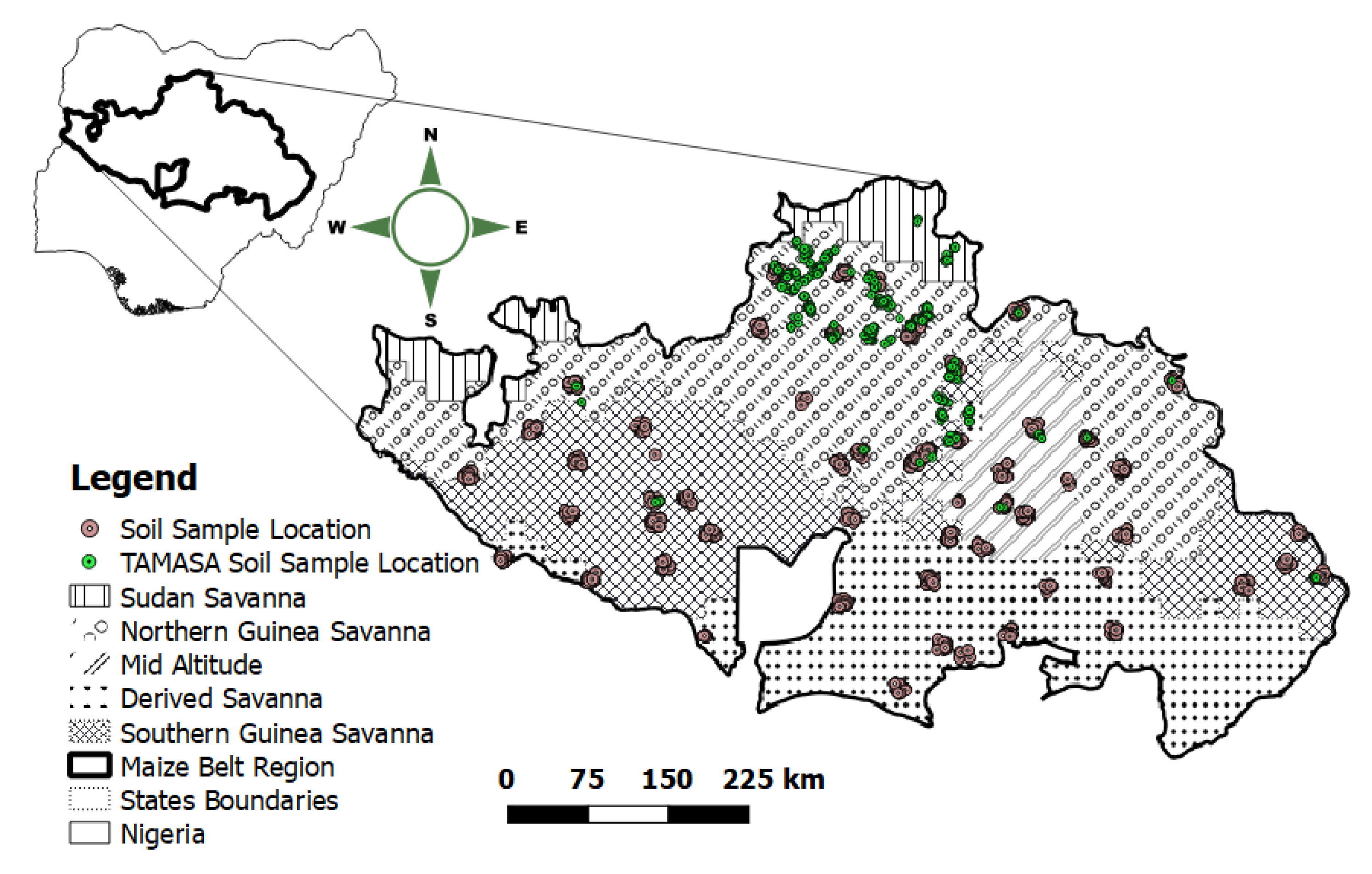
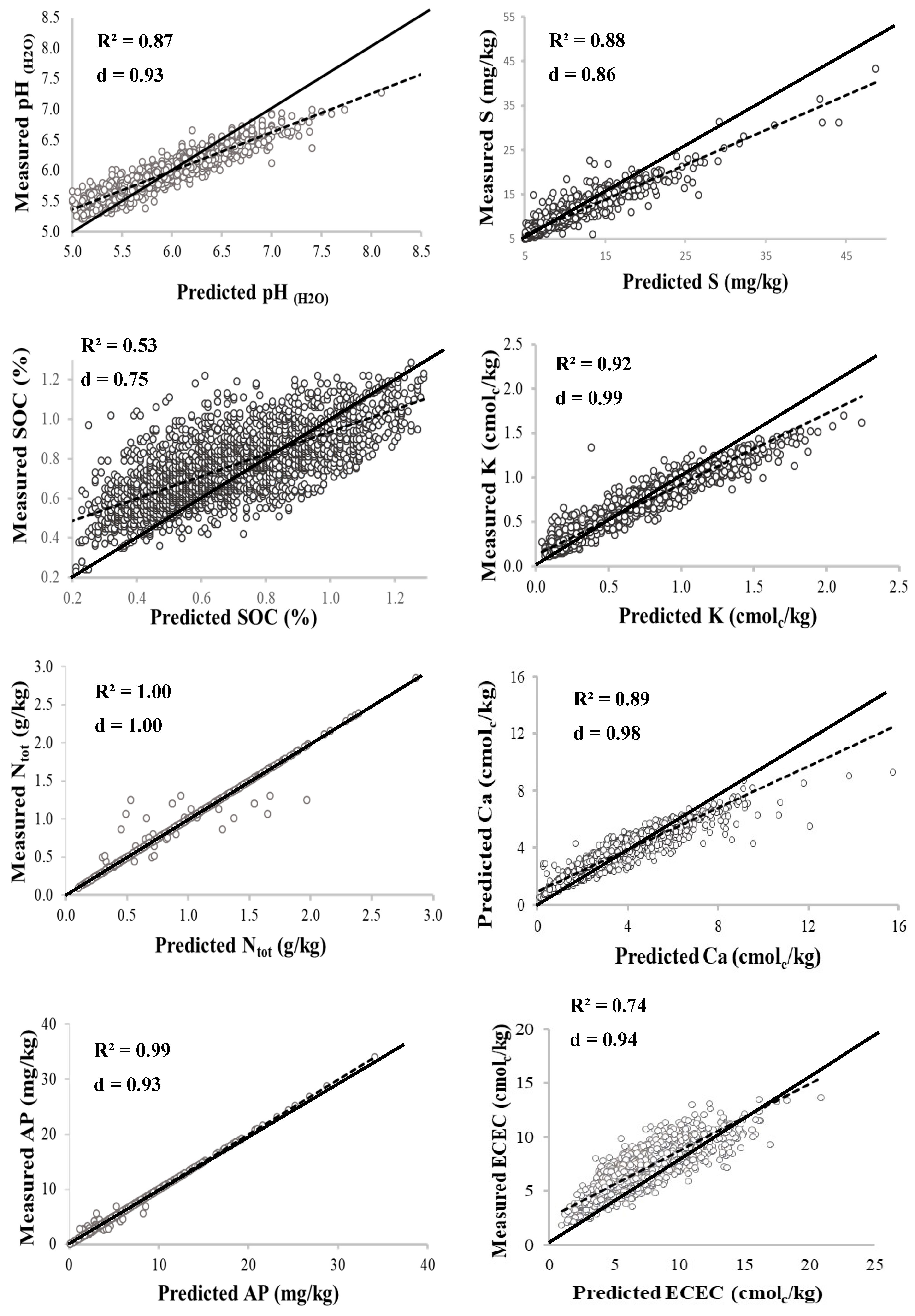
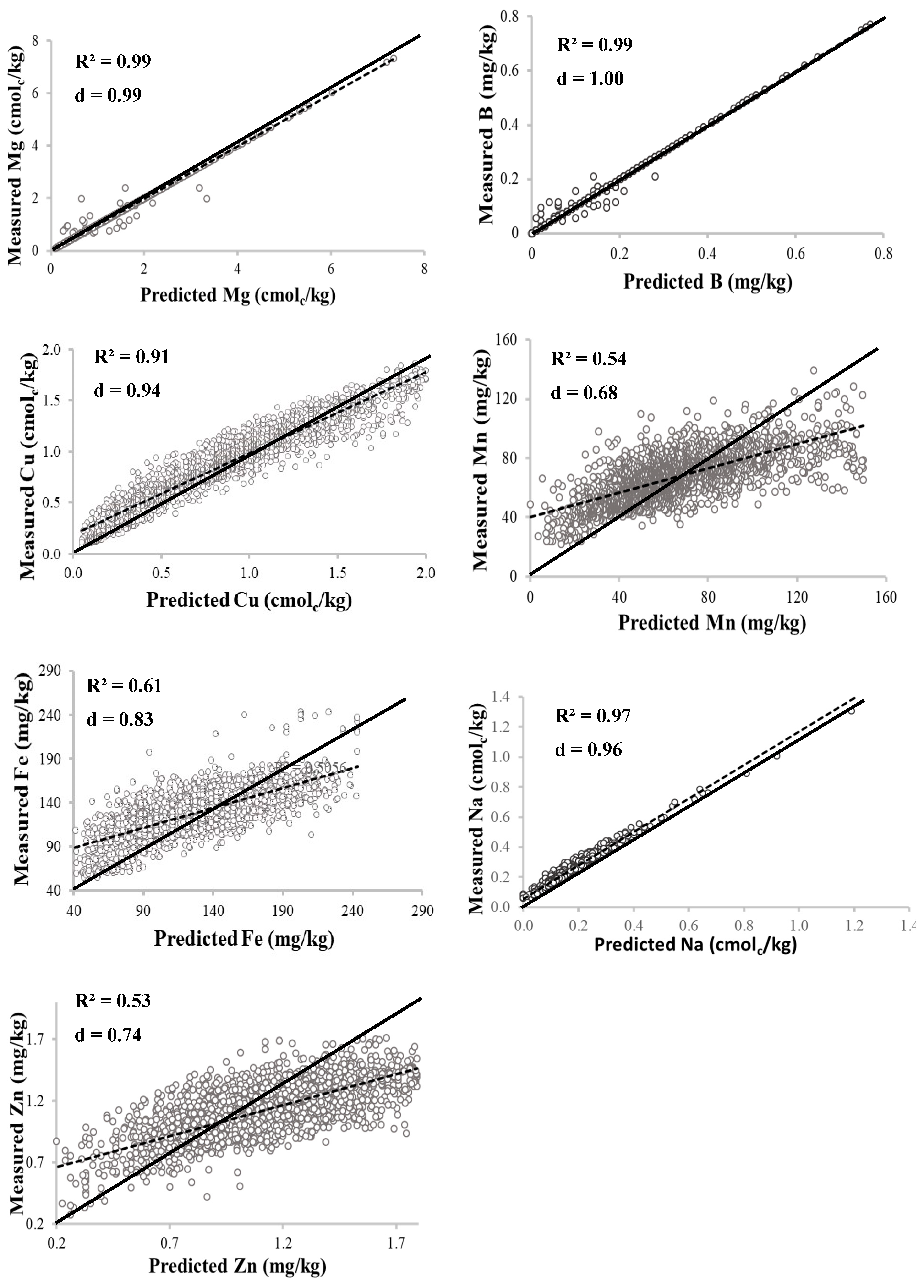
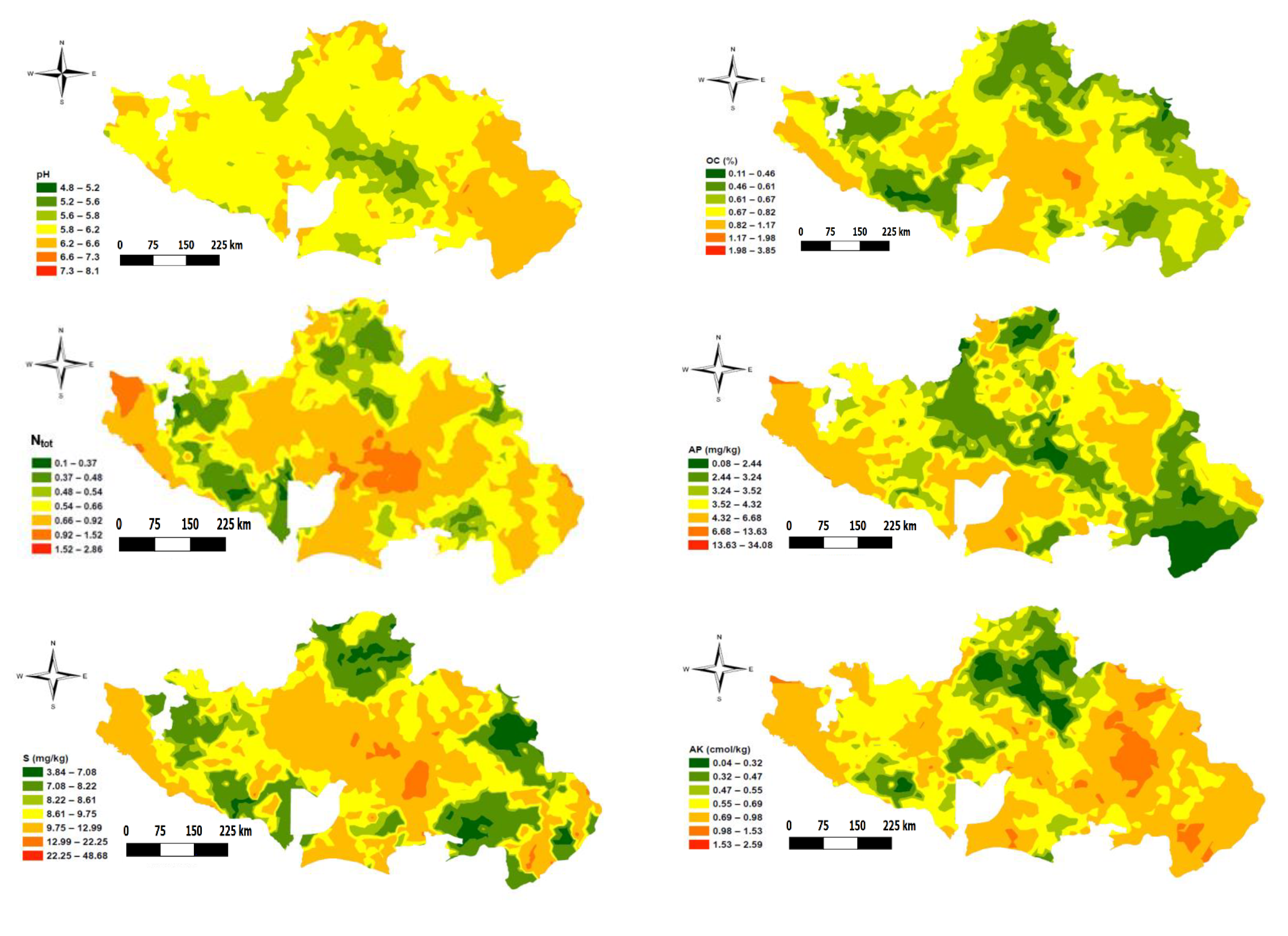
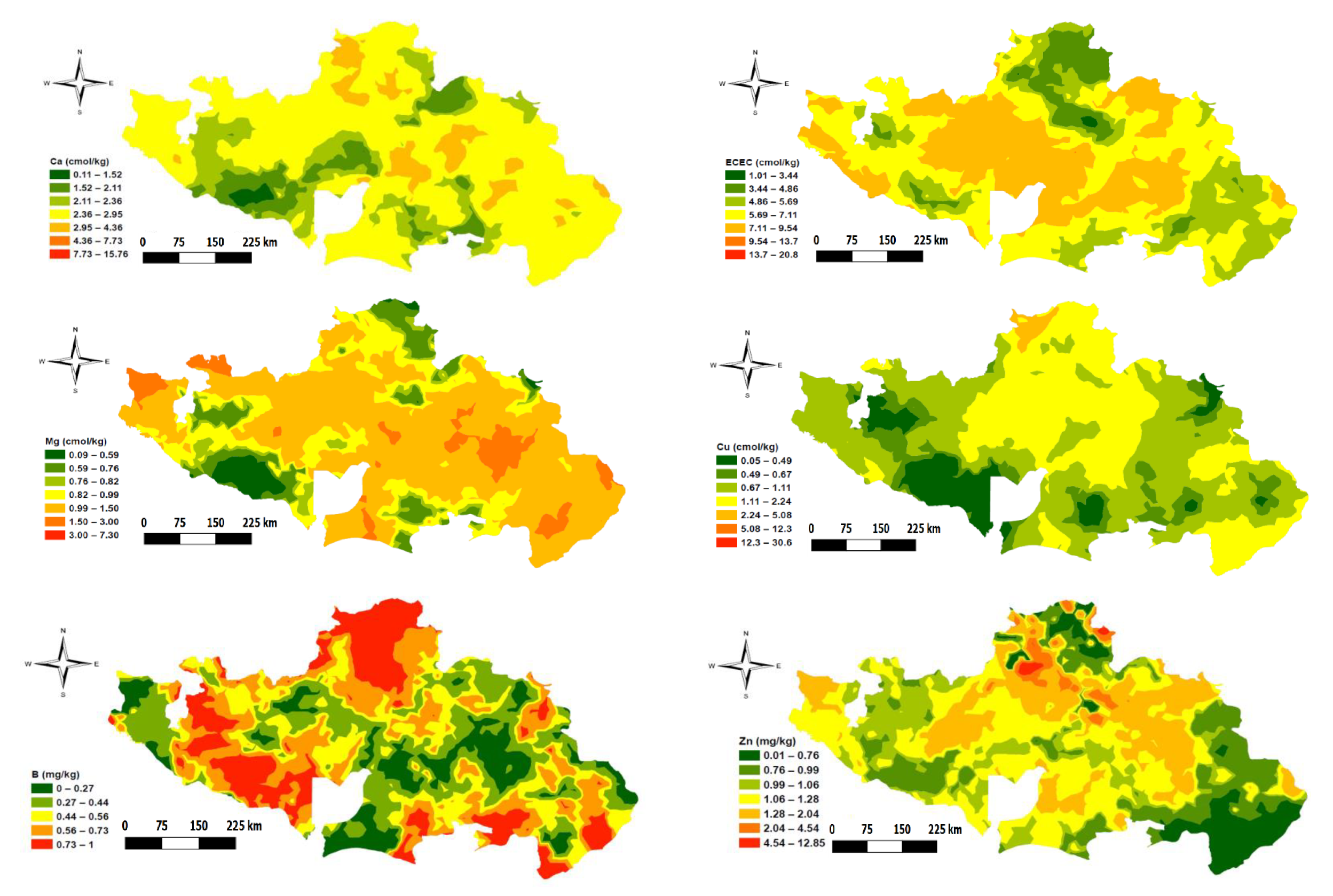
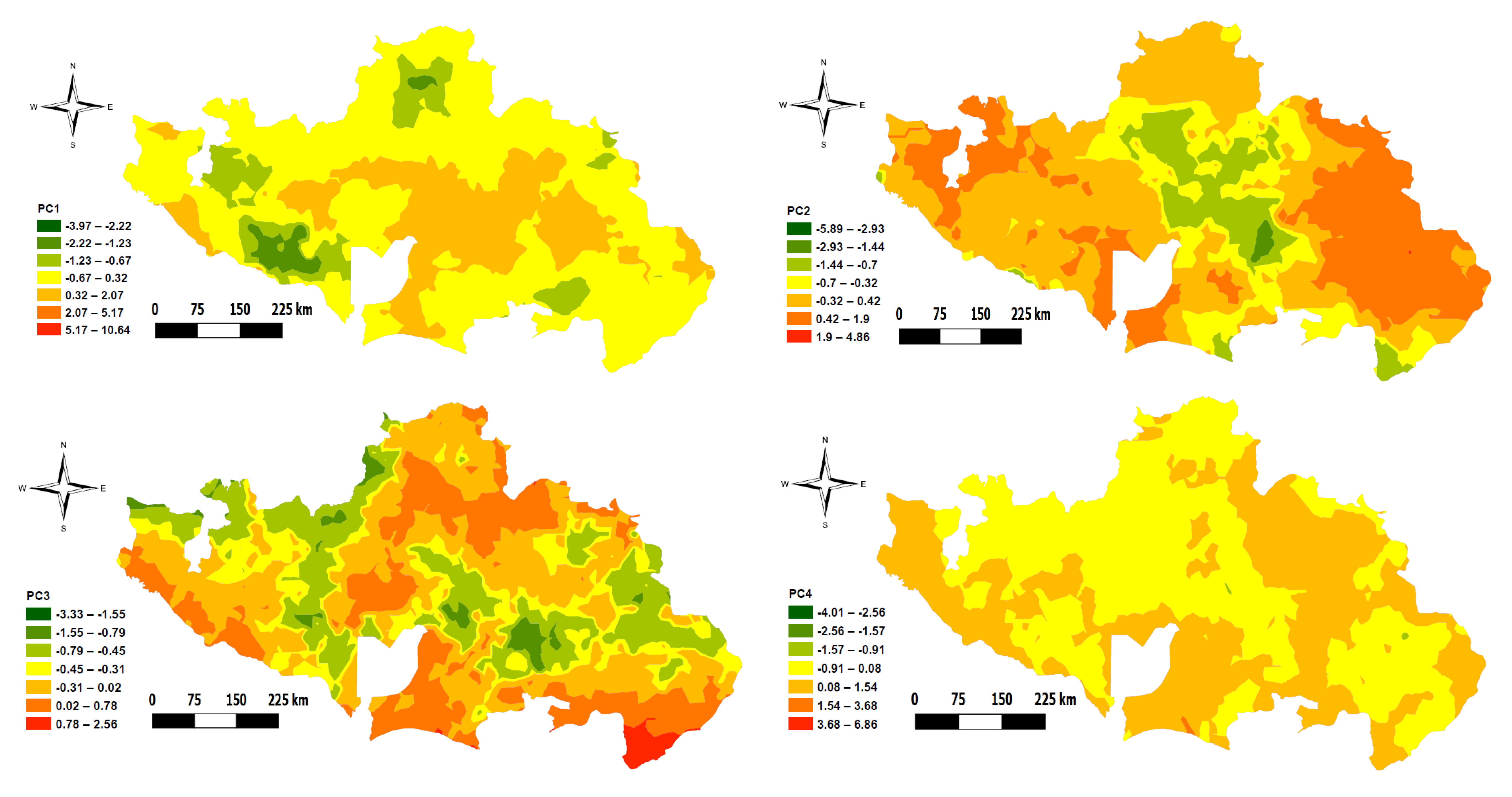
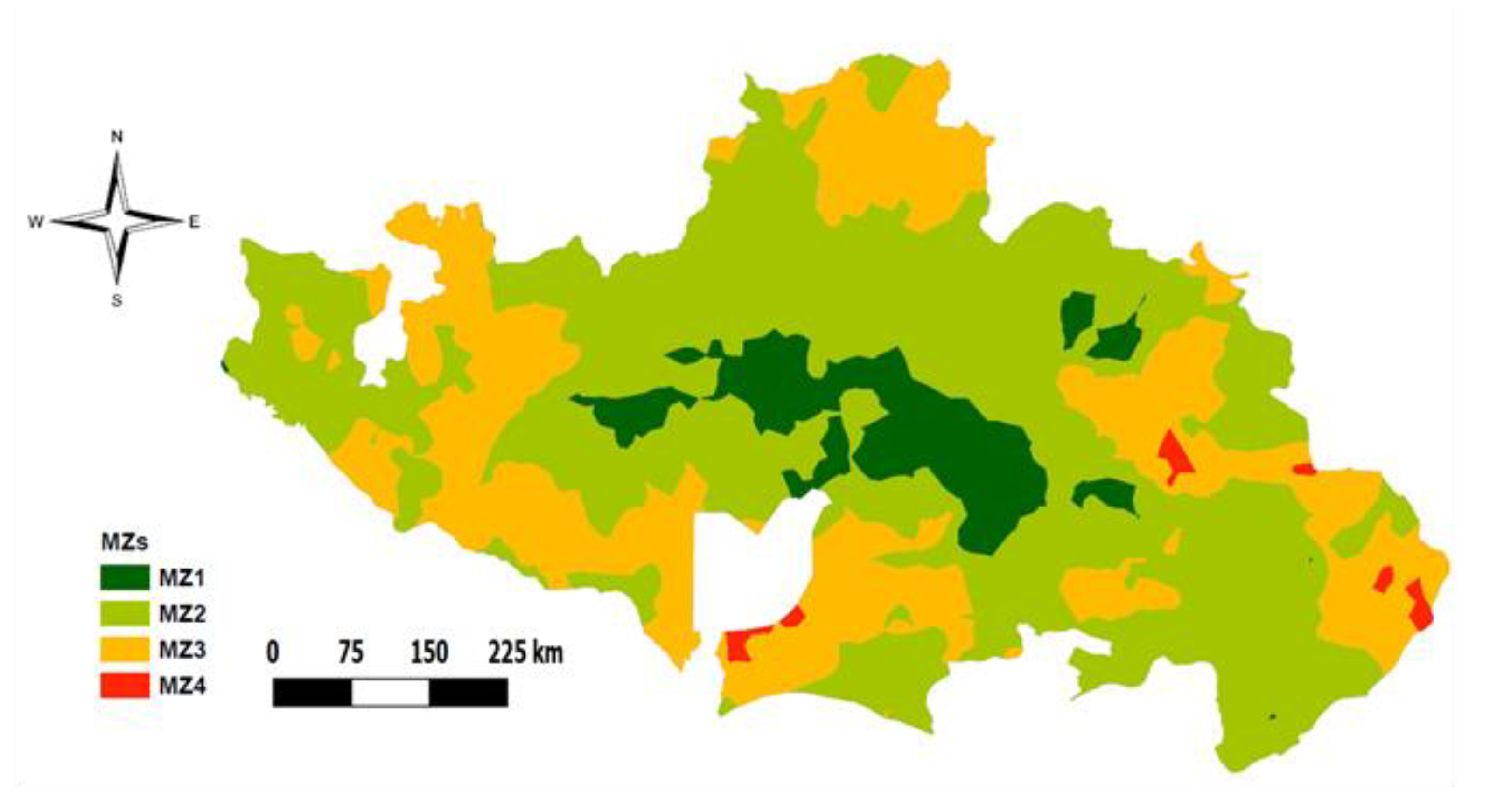
| Soil Variable | N | Mean | Upper (75%) Quartile | Lower (25%) Quartile | Minimum | Maximum | Kurtosis | Skewness | SD | CV (%) | |
|---|---|---|---|---|---|---|---|---|---|---|---|
| 1 | pH(H2O) | 2853 | 5.99 | 6.24 | 5.73 | 4.78 | 8.1 | 0.66 | 0.28 | 0.41 | 6.8 |
| 2 | SOC (%) | 2872 | 0.79 | 0.97 | 0.52 | 0.11 | 3.85 | 4.5 | 1.54 | 0.38 | 47.9 |
| 3 | Ntot (g/kg) | 2866 | 0.65 | 0.82 | 0.41 | 0.1 | 2.86 | 2.74 | 1.39 | 0.34 | 52.1 |
| 4 | AP (mg/kg) | 2828 | 4.29 | 5.17 | 2.53 | 0.08 | 34.1 | 16.39 | 3.00 | 2.78 | 64.8 |
| 5 | S (mg/kg) | 2311 | 9.80 | 11.3 | 7.1 | 3.84 | 48.68 | 12.11 | 2.43 | 4.08 | 41.9 |
| 6 | K (cmolc/kg) | 2895 | 0.65 | 0.84 | 0.41 | 0.04 | 2.59 | 0.73 | 0.73 | 0.36 | 55 |
| 7 | Ca (cmolc/kg) | 2862 | 2.84 | 3.66 | 1.69 | 0.11 | 15.76 | 3.6 | 1.36 | 1.71 | 60 |
| 8 | ECEC (cmolc/kg) | 2641 | 6.66 | 8.11 | 4.77 | 1.01 | 20.87 | 1.1 | 0.85 | 2.56 | 38.3 |
| 9 | Mg (cmolc/kg) | 2573 | 1.11 | 1.41 | 0.62 | 0.09 | 7.34 | 7.96 | 2.15 | 0.75 | 67.7 |
| 10 | Cu (cmolc/kg) | 2218 | 1.11 | 1.46 | 0.56 | 0.05 | 30.57 | 249.1 | 11.7 | 1.13 | 101.2 |
| 11 | Fe (mg/kg) | 2562 | 129.0 | 154.0 | 100.6 | 34.6 | 527.2 | 6.2 | 1.27 | 43.41 | 33.6 |
| 12 | Zn (mg/kg) | 2558 | 1.18 | 12.34 | 1.71 | 0.007 | 12.84 | 76.43 | 7.34 | 0.812 | 68.9 |
| 13 | B (mg/kg) | 2354 | 0.085 | 0.12 | 0.03 | 0.01 | 0.77 | 9.98 | 2.5 | 0.09 | 103 |
| 14 | Mn (mg/kg) | 2352 | 68.37 | 83.2 | 44.8 | 0.03 | 482.3 | 14.6 | 2.39 | 36.38 | 53.2 |
| 15 | Na (cmolc/kg) | 2524 | 0.14 | 0.16 | 0.10 | 0.00 | 1.33 | 52.65 | 4.85 | 0.07 | 52.05 |
| pH | SOC | Ntot | AP | K | Ca | S | ECEC | Mg | Cu | Fe | Zn | B | Mn | Na | |
|---|---|---|---|---|---|---|---|---|---|---|---|---|---|---|---|
| pH | 1 | - | - | - | - | - | - | - | - | - | - | - | - | - | - |
| SOC | −0.11 ** | 1 | - | - | - | - | - | - | - | - | - | - | - | - | - |
| Ntot | −0.22 ** | 0.87 ** | 1 | - | - | - | - | - | - | - | - | - | - | - | - |
| AP | 0.18 ** | 0.16 ** | 0.13 ** | 1 | - | - | - | - | - | - | - | - | - | - | - |
| K | −0.04 * | 0.42 ** | 0.42 ** | 0.10 ** | 1 | - | - | - | - | - | - | - | - | - | - |
| Ca | 0.18 ** | 0.46 ** | 0.48 ** | 0.09 ** | 0.34 ** | 1 | - | - | - | - | - | - | - | - | - |
| S | −0.30 ** | 0.55 ** | 0.60 ** | 0.03 | 0.26 ** | 0.34 ** | 1 | - | - | - | - | - | - | - | - |
| ECEC | −0.03 | 0.48 ** | 0.52 ** | 0.09 ** | 0.42 ** | 0.40 ** | 0.57 ** | 1 | - | - | - | - | - | - | - |
| Mg | 0.11 ** | 0.49 ** | 0.52 ** | 0.10 ** | 0.48 ** | 0.68 ** | 0.42 ** | 0.53 ** | 1 | - | - | - | - | - | - |
| Cu | −0.01 | 0.22 ** | 0.25 ** | 0.05 ** | −0.02 | 0.28 ** | 0.50 ** | 0.14 ** | 0.24 ** | 1 | - | - | - | - | - |
| Fe | −0.16 ** | 0.24 ** | 0.23 ** | 0.10 ** | −0.03 | 0.04 | 0.19 ** | 0.03 | 0.06 ** | 0.18 ** | 1 | - | - | - | - |
| Zn | 0.03 | 0.17 ** | 0.18 ** | 0.13 ** | 0.09 ** | 0.21 ** | 0.22 ** | 0.13 ** | 0.18 ** | 0.09 ** | 0.02 | 1 | - | - | - |
| B | 0.09 ** | 0.51 ** | 0.54 ** | 0.23 ** | 0.47 ** | 0.49 ** | 0.43 ** | 0.56 ** | 0.63 ** | 0.54 ** | 0.14 ** | 0.38 ** | 1 | - | - |
| Mn | 0.16 ** | 0.20 ** | 0.26 ** | 0.01 | 0.24 ** | 0.42 ** | 0.12 ** | 0.25 ** | 0.42 ** | 0.20 ** | −0.01 | 0.20 ** | 0.42 ** | 1 | - |
| Na | 0.06 | 0.11 ** | 0.15 ** | −0.11 ** | 0.21 ** | 0.28 ** | 0.28 ** | 0.34 ** | 0.37 ** | −0.02 | −0.04 | 0.01 | 0.21 ** | 0.07 ** | 1 |
| Variable | Model | Nugget | Partial sill | Sill | Nugget/Sill | Range (m) | RMSE |
|---|---|---|---|---|---|---|---|
| pH(H2O) | Stable | 0.011 | 0.101 | 0.112 | 0.100 | 4000.4 | 1.370 |
| SOC (%) | Stable | 0.013 | 0.147 | 0.160 | 0.082 | 8000.8 | 0.128 |
| Ntot (g/kg) | Stable | 0.001 | 0.097 | 0.098 | 0.010 | 3710.0 | 6.856 |
| AP (mg/kg) | Circular | 0.002 | 7.940 | 7.942 | 0.000 | 3999.0 | 2.440 |
| S (mg/kg) | Exponential | 0.069 | 0.066 | 0.135 | 0.510 | 3638.0 | 3.424 |
| K (cmocl/kg) | Stable | 0.023 | 0.079 | 0.102 | 0.222 | 1100.5 | 2.431 |
| Ca (cmolc/kg) | Stable | 0.322 | 0.126 | 0.447 | 0.719 | 9515.0 | 5.164 |
| Mg (cmolc/kg) | Stable | 0.063 | 0.296 | 0.359 | 0.175 | 7900.0 | 0.295 |
| Na (cmolc/kg) | Exponential | 0.005 | 0.022 | 0.026 | 0.176 | 5900.0 | 0.328 |
| ECEC (cmolc/kg) | Stable | 0.056 | 0.110 | 0.166 | 0.337 | 3598.0 | 0.697 |
| Cu mg/kg) | Exponential | 0.352 | 0.490 | 0.842 | 0.418 | 7142.5 | 1.694 |
| Fe (mg/kg) | Exponential | 0.065 | 0.066 | 0.131 | 0.493 | 4338.0 | 1.506 |
| Zn (mg/kg) | Spherical | 0.202 | 1.220 | 1.422 | 0.142 | 2241.0 | 1.589 |
| B (mg/kg) | Stable | 0.153 | 0.094 | 0.247 | 0.620 | 2940.0 | 21.514 |
| Mn (mg/kg) | Stable | 0.601 | 0.399 | 1.000 | 0.601 | 1300.0 | 28.985 |
| Principal Component | Eigen Value | Component Loading (%) | Cumulative Loading (%) |
|---|---|---|---|
| 1 | 5.102 | 34.01 | 34.01 |
| 2 | 1.697 | 11.31 | 45.33 |
| 3 | 1.389 | 9.26 | 54.59 |
| 4 | 1.133 | 7.55 | 62.14 |
| 5 | 0.948 | 6.32 | 68.46 |
| 6 | 0.906 | 6.04 | 74.50 |
| 7 | 0.807 | 5.38 | 79.88 |
| 8 | 0.655 | 4.37 | 84.25 |
| 9 | 0.563 | 3.76 | 88.0 |
| 10 | 0.540 | 3.60 | 91.61 |
| 11 | 0.413 | 2.76 | 94.36 |
| 12 | 0.347 | 2.31 | 96.68 |
| 13 | 0.277 | 1.84 | 98.52 |
| 14 | 0.133 | 0.89 | 99.41 |
| 15 | 0.089 | 0.59 | 100.0 |
| Soil Variable | PC1 | PC2 | PC3 | PC4 |
|---|---|---|---|---|
| pH(H2O) | −0.044 | 0.769 | 0.243 | 0.005 |
| SOC (%) | 0.772 | −0.325 | −0.025 | 0.276 |
| Ntot (g/kg) | 0.808 | −0.318 | −0.042 | 0.199 |
| AP (mg/kg) | 0.182 | 0.120 | 0.501 | 0.590 |
| S (mg/kg) | 0.701 | −0.421 | −0.058 | −0.258 |
| K (cmolc/kg) | 0.580 | 0.129 | −0.308 | 0.388 |
| Ca (cmolc/kg) | 0.707 | 0.323 | −0.002 | −0.095 |
| Mg (cmolc/kg) | 0.793 | 0.278 | −0.121 | −0.034 |
| Na (cmolc/kg) | 0.348 | 0.211 | −0.567 | −0.247 |
| ECEC (cmolc/kg) | 0.720 | 0.032 | −0.268 | 0.037 |
| Cu (mg/kg) | 0.438 | −0.161 | 0.490 | −0.588 |
| Fe (mg/kg) | 0.193 | −0.474 | 0.341 | 0.023 |
| Zn (mg/kg) | 0.326 | 0.127 | 0.353 | 0.039 |
| B (mg/kg) | 0.817 | 0.149 | 0.254 | −0.066 |
| Mn (mg/kg) | 0.466 | 0.418 | 0.162 | −0.167 |
| MZs | pH (H2O) | SOC (%) | Ntot (g/kg) | AP (mg/kg) | S (mg/kg) | K (cmolc/kg) | Ca (cmol/kg) |
|---|---|---|---|---|---|---|---|
| 1 | 5.83c | 1.17a | 1.02a | 3.18c | 13.18a | 1.01a | 4.24a |
| 2 | 5.73d | 0.78c | 0.69c | 3.79b | 10.64b | 0.50d | 1.87d |
| 3 | 6.07b | 0.55d | 0.42d | 3.43c | 7.49c | 0.59c | 2.20c |
| 4 | 6.13a | 1.07b | 0.86b | 8.46a | 10.02b | 0.95b | 3.35b |
| LSD | 0.043 | 0.039 | 0.035 | 0.230 | 0.447 | 0.034 | 0.182 |
| ECEC (cmolc/kg) | Mg (cmolc/kg) | Cu (mg/kg) | Fe (mg/kg) | Zn (mg/kg) | B (mg/kg) | Mn (mg/kg) | Na (cmolc/kg) |
| 9.25a | 1.86a | 1.25a | 121.9c | 1.29b | 0.15a | 79.97a | 0.19a |
| 6.58c | 0.79c | 1.20a | 164.6a | 1.05c | 0.07b | 61.64b | 0.13c |
| 5.67d | 0.78c | 0.57c | 102.2d | 1.01c | 0.04c | 60.69b | 0.14b |
| 7.89b | 1.50b | 1.08b | 142.6b | 1.42a | 0.15a | 79.93a | 0.14b |
| 0.267 | 0.081 | 0.064 | 3.739 | 0.038 | 0.010 | 3.621 | 0.009 |
© 2020 by the authors. Licensee MDPI, Basel, Switzerland. This article is an open access article distributed under the terms and conditions of the Creative Commons Attribution (CC BY) license (http://creativecommons.org/licenses/by/4.0/).
Share and Cite
Aliyu, K.T.; Y. Kamara, A.; M. Jibrin, J.; E. Huising, J.; M. Shehu, B.; Adewopo, J.B.; B. Mohammed, I.; Solomon, R.; M. Adam, A.; M. Samndi, A. Delineation of Soil Fertility Management Zones for Site-specific Nutrient Management in the Maize Belt Region of Nigeria. Sustainability 2020, 12, 9010. https://doi.org/10.3390/su12219010
Aliyu KT, Y. Kamara A, M. Jibrin J, E. Huising J, M. Shehu B, Adewopo JB, B. Mohammed I, Solomon R, M. Adam A, M. Samndi A. Delineation of Soil Fertility Management Zones for Site-specific Nutrient Management in the Maize Belt Region of Nigeria. Sustainability. 2020; 12(21):9010. https://doi.org/10.3390/su12219010
Chicago/Turabian StyleAliyu, Kamaluddin T., Alpha Y. Kamara, Jibrin M. Jibrin, Jeroen E. Huising, Bello M. Shehu, Julius B. Adewopo, Ibrahim B. Mohammed, Reuben Solomon, Adam M. Adam, and Ayuba M. Samndi. 2020. "Delineation of Soil Fertility Management Zones for Site-specific Nutrient Management in the Maize Belt Region of Nigeria" Sustainability 12, no. 21: 9010. https://doi.org/10.3390/su12219010
APA StyleAliyu, K. T., Y. Kamara, A., M. Jibrin, J., E. Huising, J., M. Shehu, B., Adewopo, J. B., B. Mohammed, I., Solomon, R., M. Adam, A., & M. Samndi, A. (2020). Delineation of Soil Fertility Management Zones for Site-specific Nutrient Management in the Maize Belt Region of Nigeria. Sustainability, 12(21), 9010. https://doi.org/10.3390/su12219010






